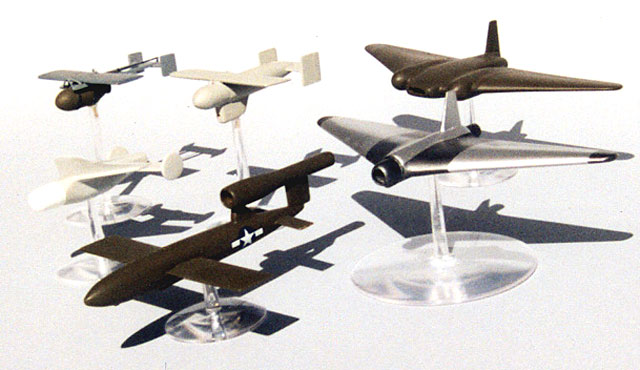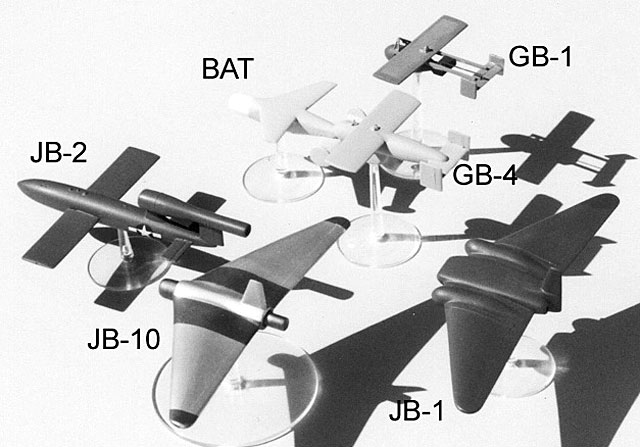|
Predatorís Ancestors
Glide Bombs and
Jet Bombs of
World War Two
by Tom Conte

HyperScale is proudly supported by
Squadron.com
Watching the latest news we see a number of remarkable aircraft.
These unmanned aerial vehicles are a source of amazement as they go
about their task and strike seemingly impossible targets. Few
realized that their operational beginnings go back to the 1940ís.
These models built in 1/72 scale represent the height of guided
technology of World War Two. With the
Assault
Drones, described in other features on the HyperScale website,
these devices were the start of the lineage of guided weapons that
resulted in the aircraft we so recently saw in action.
Glide Bombs
The Glide Bomb weapons were standard 2000 pound bombs that were
given lifting surfaces and means of guidance. The GB-1 was simply
directed by surfaces under the controlled of an onboard gyroscope
and received no outside commands. GB-4 was a more complex weapon
using the same size bomb, but had a television camera installed on
its belly. Using it, the bombardier could follow the weapons flight
and remotely give it commands and fly it into a target.

These were used against targets in Cologne, Germany and Le Havre
France during 1944. They were dropped by B-17s from the aircraftís
wing mounted bomb racks.
These models were made from True Details 2000 pound bombs and
styrene plastic sheets. The aft section of the GB-4 was created from
a larger scale drop tank cut and sanded to shape. Both have a two
inch wingspan in this scale.
SWOD BAT
The SWOD BAT is described in another Feature on the Hyperscale
web site. A master was made since two were carried and dropped from
a PB4-Y Privateer. All together three were produced using Bare Metal
Foilís Pour A Cast resin, two that are hung on a Privateer model and
the one shown here. The model is about two inches long.
BATs were used against Japanese targets starting the spring of
1945. Using the onboard radar guided system BATs struck a number of
ships and land targets.
Jet Bomb Two
The Jet Bomb Two was an American copy of the Germanís V-1.
Republic Aircraft built the airframe while Ford produced the pulse
jet engine. Many were in the process of being readied in
anticipation for the attack of Japan.
The model was created by modifying a V-1 model, with most of the
work being done around the forward pylon.
Jet Bombs One and Ten
The Northrop Jet Bomb One and Ten were also intended to strike
Japanese targets. Both were to be launched, like the JB-2 using a
rocket propelled sled to bring them up to speed. JB-1 was to be
powered by a simplified turbo-jet engine but its development was
becoming too costly. The turbo-jet engine was replaced by a pulse
jet engine and this version was designated the JB-10.
 Since
both JBs and a few other Northrop projects I am planning to make use
generally the same wings, I created a master set and cast them using
the Pour A Cast resin. The different center sections were then
scratchbuilt from styrene sheets and tubes and the wings were CA
glued onto them. Since
both JBs and a few other Northrop projects I am planning to make use
generally the same wings, I created a master set and cast them using
the Pour A Cast resin. The different center sections were then
scratchbuilt from styrene sheets and tubes and the wings were CA
glued onto them.
The JBs used magnesium in their construction and I used the
Testorís Model Masters color to paint the JB-10 since photos show a
bare metal wing. Testorís solvent based paints were used on all the
models. The JBs models have a wing span of 4.625 inches.

There were a number of other guided weapons under devolvement
during this time period, but these were the ones that either saw
action or were in the process of being readied for the attack that
was planned for the Fall of 1945 on Japan.
These models make a nice contrast that compliments the larger
bomber types in my model collection.
Review and Images Copyright © 2002 by Tom Conte
Page Created 02 June, 2003
Last updated
25 March, 2004
Back to HyperScale Main
Page
Back to Reviews
Page
|
Home |
What's New |
Features |
Gallery |
Reviews |
Reference |
Forum |
Search